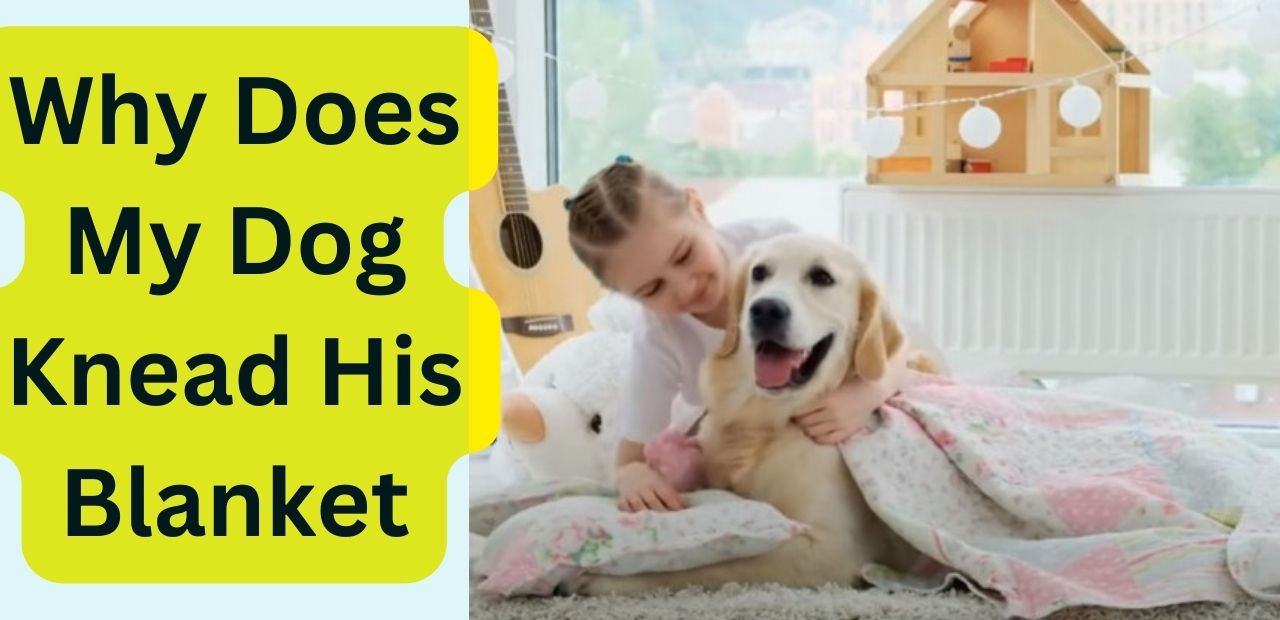If you are a dog lover you should know, Why Does My Dog Knead His Blanket?
Dogs knead their blankets to create a comfortable sleeping spot and mark their territory with scent glands in their paws. Many dog owners have observed their furry companions engaging in a curious behavior: kneading their blankets with their paws.
At first glance, this action might seem perplexing or amusing, but it serves a purpose for canines. Just like with cats, dogs also exhibit this behavior for various reasons. Understanding why your dog kneads their blanket can provide insight into their instinctual behaviors and offer a glimpse into their ancestral habits.
In this article, we will delve into the reasons behind this behavior, exploring the biological and instinctual motivations that drive dogs to knead their blankets. So, without further ado, let us unravel the mystery of why dogs engage in this peculiar behavior.
Understanding The Natural Instincts Behind Kneading
Dogs And Their Ancestral Behaviors
Exploring The Origins Of Kneading Behavior
Kneading is a common behavior observed in dogs that is reminiscent of their ancestral instincts. There are several key factors that contribute to this behavior, shedding light on why your dog kneads his blanket.
Connecting Kneading To Survival Instincts
One of the primary reasons dogs knead is rooted in their survival instincts. In the wild, dogs would knead the ground or foliage to create a comfortable spot to rest or sleep. This instinctual behavior helped them to prepare their sleeping area and ensure it was safe from any potential dangers.
The Link Between Kneading And Territoriality
Kneading is also connected to a dog’s territorial instincts. By kneading their blanket or bed, dogs release their scent glands through their paws, marking the area as their own. This behavior serves as a way for dogs to establish their territory and communicate their presence to other animals.
How Kneading Mimics Puppyhood Behavior
Kneading behavior in dogs bears resemblance to the actions of puppies. When puppies nurse, they use their paws to push against their mother’s mammary glands to stimulate milk production. As they grow older, this habit often carries on, leading to kneading behavior in adulthood.
So, when your dog kneads his blanket, it might be because he feels safe and secure, reminiscent of his puppyhood days.
Understanding these natural instincts behind kneading can help you comprehend why your furry friend engages in this behavior. Whether it is a way to create a comfortable space, establish territory, or simply a puppy-like habit, kneading remains a fascinating and endearing trait among dogs.
Seeking Comfort And Bonding Through Kneading

Dogs are fascinating creatures with their own unique behaviors and quirks. One interesting behavior that you may have observed your furry friend engaging in is kneading his blanket. But have you ever wondered why dogs do this? In this blog post, we will delve into the reasons behind this kneading behavior and explore the various ways it serves as a source of comfort and bonding for your canine companion.
The Role Of Socialization In Kneading Behavior:
- Dogs are social animals and in their early stages of life, they learn important skills through socialization with their mother and littermates. Kneading behavior can be traced back to the time when puppies nursed from their mother.
- During nursing, puppies use their paws to knead their mother’s belly to stimulate milk production. This action becomes ingrained in their behavior and they continue to knead even as adults.
Understanding The Emotional Significance Of Kneading:
- Kneading serves as a form of self-comfort for dogs. It invokes feelings of warmth and security, reminiscent of their time spent with their mother.
- This behavior may be seen in moments of relaxation or when your dog is feeling content and safe in his environment.
- The repetitive motion of kneading may also serve as a way for dogs to release pent-up energy or relieve stress.
Kneading As A Form Of Self-Comfort:
- The act of kneading stimulates the release of endorphins in your dog’s brain, which brings about a sense of pleasure and relaxation.
- The rhythmic motion of kneading can have a soothing effect on your dog, helping them to feel calm and at ease.
- Your dog may choose to knead on soft surfaces such as blankets, pillows, or even your lap, as these provide a comfortable and comforting texture.
Bonding And Trust-Building Through Kneading:
- Kneading behavior can also serve as a way for dogs to bond with their human companions. By kneading on your lap or beside you, they are seeking physical closeness and enhancing the bond between you.
- This behavior is often seen in dogs that have a strong connection with their owners and feel secure in their presence.
- When your dog kneads on you, it is a sign of trust and affection. It shows that they feel comfortable and safe enough to display this vulnerable behavior.
The Connection Between Kneading And Scent-Marking:
- Dogs have scent glands in their paws, and by kneading, they are leaving their scent on the surface they are kneading on.
- This behavior serves as a way for dogs to mark their territory and communicate their presence to other dogs and animals.
- Scent-marking through kneading can also signal to other dogs that a particular area or object is claimed by your dog.
As you can see, there are multiple reasons why your dog may engage in kneading behavior. Whether it is seeking comfort, bonding with you, or marking its territory, kneading is an instinctual behavior that is deeply ingrained in dogs. So the next time you observe your furry friend kneading his blanket, appreciate the unique and complex ways dogs find comfort and connection in their environment.
Uncovering Medical And Behavioral Reasons For Kneading

Dogs are fascinating creatures with unique behaviors, and one of the quirkiest behaviors is kneading. Have you ever wondered why your furry friend kneads his blanket with such determination? It turns out that there could be both medical and behavioral reasons behind this adorable yet puzzling behavior.
Let’s delve deeper into these reasons and gain a better understanding of why your dog loves to knead.
Addressing Potential Health Concerns Related To Kneading
Some dogs may knead their blankets due to an underlying medical issue. It’s important to address these concerns to ensure your pet’s well-being. Here are a few medical reasons that may contribute to your dog’s kneading behavior:
- Skin issues and allergies: Skin allergies or irritations can cause discomfort, leading your dog to knead in an attempt to alleviate the itchiness or pain.
- Pain and discomfort: Dogs may knead their blankets as a response to medical conditions such as arthritis or muscular discomfort. This behavior could be their way of relieving pain or finding a comfortable position.
- Neurological conditions: Certain neurological conditions, like epilepsy or peripheral neuropathy, can trigger kneading behavior in dogs. If your dog exhibits other unusual symptoms alongside kneading, it’s best to consult a veterinarian.
Exploring Behavioral Triggers For Kneading
Besides medical reasons, there are also behavioral factors that can contribute to your dog’s kneading habits. Understanding these triggers can help you address any underlying issues or reinforce positive behaviors. Let’s take a closer look at a couple of common behavioral triggers for kneading:
- Anxiety and stress: Dogs often knead their blankets as a self-soothing behavior when they feel anxious or stressed. Identifying the source of their anxiety and providing appropriate measures to alleviate it can help reduce kneading behavior.
- Attention-seeking behavior: Kneading can be a way for dogs to seek attention from their owners. If your dog associates kneading with getting your attention, they may continue this behavior in hopes of receiving praise or interaction.
By recognizing the potential medical and behavioral reasons behind your dog’s kneading behavior, you can effectively address any concerns and provide the necessary support. Whether it’s attending to their health needs or helping them through behavioral challenges, being observant and responsive as a dog owner can enhance your bond with your furry companion.
So the next time you see your dog kneading his blanket, remember that there could be more to it than just a simple love for soft fabrics.
Preventing Excessive Or Destructive Kneading
Recognizing When Kneading Becomes Problematic
If your dog’s kneading behavior becomes excessive or destructive, it’s important to address the issue promptly. Here are some key points to consider:
- Excessive kneading can lead to frayed blankets or other damage to furniture and fabrics. It may also be a sign of anxiety or stress in your dog.
- Destructive kneading, such as scratching or digging at the blanket, can cause further damage and may indicate a deeper behavioral issue.
- Watch out for signs of obsession or fixation with kneading, such as an inability to stop or becoming agitated when unable to knead.
Providing Alternative Outlets For Kneading Behavior
To prevent excessive or destructive kneading, it’s important to provide your dog with alternative outlets for this natural behavior. Consider the following options:
- Provide your dog with an appropriate-sized soft toy or pillow that they can knead without causing damage.
- Invest in a designated dog bed or blanket specifically meant for kneading, allowing your dog to engage in the behavior without causing harm to other household items.
- Consider offering a scratching post or mat where your dog can dig and knead, redirecting their instinctual behavior to an appropriate surface.
Engaging In Interactive Play Sessions
Regular interactive play sessions with your dog can help alleviate any pent-up energy or anxiety that may be driving their excessive kneading behavior. Here’s what you can do:
- Engage in daily play sessions, using toys like squeaky balls or tug ropes to keep your dog mentally and physically stimulated.
- Incorporate puzzle toys or treat-dispensing toys into playtime to provide mental stimulation while rewarding your dog for their engagement.
- Play interactive games like hide-and-seek or fetch to keep your dog entertained and focused on positive behaviors instead of kneading.
Implementing Positive Reinforcement Training Techniques
Training techniques based on positive reinforcement can help redirect your dog’s kneading behavior and reinforce desired behaviors. Consider the following tips:
- Whenever you catch your dog engaging in appropriate kneading behavior, praise and reward them with treats or verbal encouragement.
- Use clicker training to create positive associations with desirable behaviors and redirect their focus away from destructive kneading.
- Consistency is key – be patient and persistent in reinforcing desired behaviors while redirecting or discouraging excessive kneading.
Seeking Professional Help If Needed
If your dog’s excessive kneading persists or becomes uncontrollable, it may be best to seek professional help from a veterinarian or a certified dog behaviorist. Here’s what to consider:
- A veterinarian can rule out any underlying medical conditions that may be contributing to your dog’s excessive kneading.
- A certified dog behaviorist can assess your dog’s behavior and develop a tailored training plan to address the excessive kneading and associated issues.
- Seek professional help if your dog’s kneading causes injury to themselves or others, or if it significantly disrupts their daily routine or quality of life.
Visit More Post:
Why is My Dog Bigger Than His Parents? Amazing Explained
FAQ For Why Does My Dog Knead His Blanket
Why Does My Dog Knead His Blanket?
Dogs knead their blankets as a natural instinct from their ancestry. It mimics the motion puppies make to stimulate milk flow from their mother while nursing. Kneading is also a way for dogs to mark their territory with their scent and to show comfort and relaxation.
It’s a behavior that brings them comfort and security.
Is It Normal For Dogs To Knead Blankets?
Yes, it is normal for dogs to knead blankets. Many dogs engage in this behavior as a way to mark their territory, show comfort, and relax. Kneading is a natural instinct that stems from their ancestral behaviors and is often seen as a way for dogs to find comfort and security.
How Can I Stop My Dog From Kneading His Blanket?
If you wish to stop your dog from kneading his blanket, you can redirect his behavior by providing him with an alternative activity such as playing with a toy or going for a walk. Additionally, providing him with a comfortable bed or blanket specifically designed for dogs may help reduce this behavior.
What If My Dog Kneads Excessively?
Excessive kneading may be a sign of anxiety, stress, or discomfort in your dog. It’s important to observe your dog’s overall behavior and body language. If you notice other signs of distress, it’s best to consult with a veterinarian or a professional dog behaviorist to determine the underlying cause and find appropriate solutions.
Is Kneading A Sign That My Dog Is Happy?
Yes, kneading is often a sign that your dog is happy and content. Dogs engage in this behavior to mark their territory, show comfort, and relax. If your dog looks relaxed and content while kneading his blanket, it is likely a sign that he is feeling secure and happy in his environment.
When Do Dogs Typically Knead Their Blankets?
Dogs may knead their blankets at various times, such as when they are getting ready to sleep, when they are feeling comfortable and relaxed, or when they are in need of some reassurance and security. This behavior is common and can be seen throughout the day as a way for dogs to find comfort and express themselves.
Conclusion
To sum up, understanding why your dog kneads his blanket is key to strengthening your bond with him. It’s a natural, instinctual behavior that stems from their ancestry. While some dogs knead to mark their territory and create a comfortable nest, others do it as a way to show affection and seek attention.
Whatever the reason may be, providing your furry friend with a soft and cozy blanket encourages this behavior and offers them a sense of security. Take note of your dog’s body language and behavior during kneading sessions, as it can also provide insights into their emotional state.
Remember to show patience and understanding when witnessing this adorable behavior, as it is a harmless and delightful characteristic of your canine companion. Ultimately, by appreciating and embracing your dog’s kneading habits, you are strengthening the special bond you share with your furry friend.











